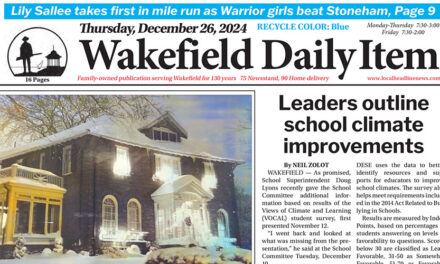Published June 26, 2019
By MARK SARDELLA
WAKEFIELD — Water and sewer rates are going up for fiscal year 2020 (which begins July 1, 2019) and there will also be a combined $38 per quarter service charge. After a public hearing this week, the Town Council approved the rate increases and new fees as recommended by the Advisory Board of Public Works.
Beginning July 1, the new water rate will be $7.30 per 100 cubic feet of consumption, which is up from $6.95 last year. In addition, water customers will be assessed an $18-per-quarter service charge.
The new sewer rate will be $11.20 per 100 cubic feet, up from the current $10.95. A $20 per quarter service fee will also be charged.
DPW Director Richard Stinson and Assistant Director Joseph Conway appeared before the Town Council Monday night to present the new rates.
Stinson noted that prior to 2007 the water and sewer rates had included a service charge. He said that the Advisory Board of Public Works strongly felt that the rate formula should once again include a service charge. Stinson explained the rationale behind the service charges.
“If we did not sell one drop of water or discharge on gallon of sewer, we would still expend approximately 90 to 95 percent of the water and sewer budgets due to the MWRA assessments, complying with regulatory requirements, required maintenance and required billing services,” Stinson said. “There is a cost associated whether or not a customer utilizes the water and sewer system.”
Stinson said that the new water rate plus the $18 per quarter service charge provides for an average annual water bill (after discount) of $853.20 or $213.30 per quarter.
The new sewer rate plus the $20 per quarter service charge will result in an average annual sewer bill (after discount) of $1,281.60, or $320.40 per quarter.
The combined average annual water and sewer bill for FY2020 will be $2,134.80 or $533.70 per quarter (after the discount is taken). This represents an increase of $131.40 or $32.85 per quarter. This amounts to a 6.559 percent combined rate increase.
Stinson noted that both the water and sewer rates need to fund the operating budget and need to be sufficient to provide for consumption shortfalls, emergencies and future capital improvements. He said that consumption in FY 2019 was lower than anticipated and impacted reserves.
The MWRA assessments continue to be the most significant factor in both the water and sewer budgets, Stinson said. The MWRA sewer assessment increased 5.6 percent and represents 77.02 percent of the sewer budget. The MWRA Water assessment increased 21 percent and represents 46.36 percent of the water budget.
Stinson said that consumption was down slightly in FY 2019, and that impacted revenues and reserves. In addition, Crystal Lake was shut down for more than three months due to manganese conditions, forcing the town to obtain more water from the MWRA.
Stinson stressed that a gallon of Wakefield tap water at about 0.02 cents per gallon is better quality and far cheaper than a 16 ounce bottle of water selling in stores for about $1.50.
The Town Council also approved the recommended sewer flat rate (for users of well water) of $320.40 (after discount).
The septic disposal rate remained the same as last year at $110 per delivery. Stinson said that the town is required by law to provide for septic disposal but the service is used no more than once or twice a year.
A meter fee of $50 remains the same at last year, although it has never been assessed.
There was no one from the public at the hearing who wished to provide testimony on the new water and sewer rates.
The Town Council also approved recommended updates to one-time fees that the town charges to developers of large projects that place a new burden on the water or sewer system.
The Town Council also approved the Advisory Board of Public Works recommendation to extend until the year 2022 the moratorium on second water meters for systems not connected to the sewer system. For most homeowners, this relates to in-ground irrigation systems. Since sewer use is calculated based on water consumption, allowing second water meters for water that does not go into the sewer system would only shift the financial burden to homeowners who do not install second meters.




